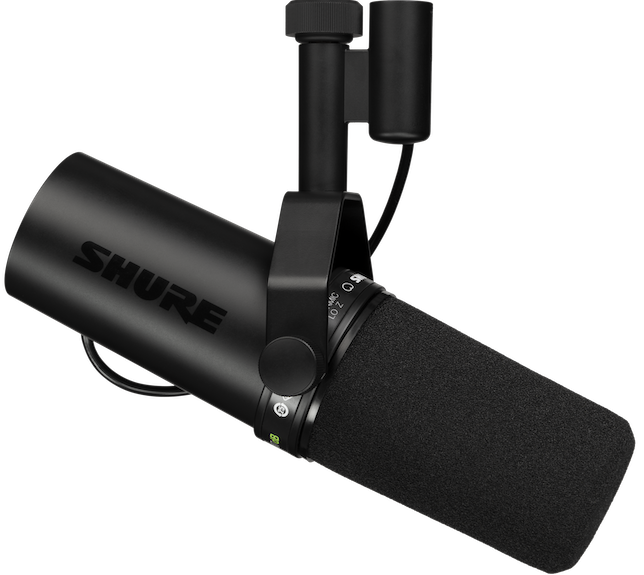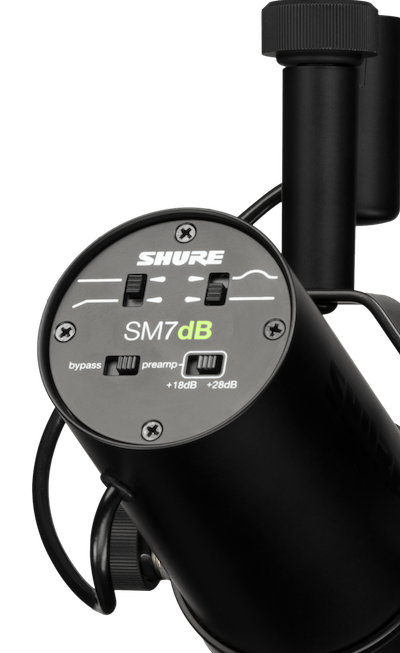
Barry's Mix Magazine Equipment And Software Reviews
Barry's Massive Discography And Engineering Career
Barry's Music Connection Magazine Reviews
Barry's Resolution Magazine Reviews
Shure Microphones SM7dB Vocal Microphone
Versatile Mic Adds 3-Mode Operation Excels On Loud Sources
By Barry Rudolph
 |
| Shure's SM7dB Vocal Microphone |
Originally released in 1973, the Shure SM7 Vocal Microphone (updated in the early 2000s to the SM7B) joined the Shure SM57 and SM58 as one of the company's three moving-coil, cardioid, dynamic microphones based on the Shure SM5A/SM5B/SM5C Series Boom Microphone, which was introduced in 1964.
The three models of SM5 have hum-bucking coils that provide up to 4 dB of hum rejection. The SM5A and SM5C were 50-ohm mics with the SM5C including a steep bass roll-off; the SM5B was a 150-ohm mic. The full-range SM7B is smaller overall and replaced the large, bulbous-shaped SM5 that was discontinued in 1988.
The Shure SM57, SM58, and SM7B use variations of the Shure Unidyne III element, but the SM7B's diaphragm design, along with additional acoustic space behind it (compared to the SM57/SM58) allows for more low frequency extension and overall flatter response. Other primary differences are the SM7B's "yoke," or gimbal mount, an internal "air suspension" shock mount, and two interchangeable windscreens. The SM7B also featured two frequency response switches on the rear of the mic body.
What's New About The SM7dB?
The new SM7dB is the first upgrade or variant of the SM7B in 20 years and, for the first time, Rodger Cloud has licensed a custom Shure-designed, built-in pre-amp tuned by Shure engineers specifically for this new mic.
The SM7dB has three operating modes: Bypass and two pre-amp modes with either +18dB or +28dB of additional gain. These are set with slide switches on the back of the mic and replace the original's (without pre-amp) flush-mounted filter switches. The pre-amp requires +48-volt phantom power, but you can leave it always on and freely switch back and forth between the original SM7B in Bypass mode and then the SM7dB with the additional gain if you like it.
In the Bypass mode, the mic's XLR connector is directly connected to the mic element's coil, and no phantom power is required. (More later) Shure assured me that the Bypass mode sounds exactly like a SM7B microphone in every way with the same output impedance of 150-ohms and the same sensitivity of -59dBV Pa.
However, with phantom power switched on and in either pre-amp mode, the output impedance drops to 27-ohms and the rated sensitivity will increase to -41dBV/Pa for the +18dB boost position and -31dBV/Pa for the +28dB boost. Just for reference, a Shure SM57 has an output impedance of 310-ohms and a sensitivity of -56dBV/Pa while the typical Neumann U87 Ai condenser microphone is rated at -28dBV/Pa sensitivity.
The +48-volt phantom power is required for the SM7dB's active modes and you may freely switch between them while phantom is applied without a problem. However, as a standard procedure, always mute the channel/mic pre-amp inputs connected to the SM7dB's output before initially switching on/off phantom power.
 |
| Controls on the back of the SM7dB |
A Major Update
Other updates include: four easy-to-adjust slide switches replace the recessed switches used in the SM7B. These switches change between Bypass, +18dB or +28dB of boost and both the high-pass filter and presence boost on/off.
According to the enclosed chart, the high-pass filter or bass roll-off starts at about 350Hz and continues down to 50Hz. The Presence boost starts at 900Hz and continues up to about 7kHz with a maximum boost of never more than about 4dB--in fact the microphone is "ruler flat" in response from 1kHz to over 4kHz.
The effects these filters are the same in either Bypass or Active modes, and the same as the original SM7B microphone. However, the new slide switches are easier to use but protrude slightly precluding the use of the rear security cover plate as supplied with the SM7B.
The SM7B's popularity stems from its wide range of uses from radio station DJs to recording loud singers, guitar amps and drum kits. It is a full-range, rugged dynamic microphone that has been an enormously successful microphone for Shure. However, for very quiet sources--whisper vocals, fingerpicking guitar parts, or certain percussion instruments and Foley recording to get obtain proper recording level, requires about 60 to 75dB of mic gain.
For the professional recording engineer using proper gear, this low output is not a problem. But it can be problematic for the inexperienced or beginning artist/producer/engineer using an inexpensive USB interface and expecting condenser microphone-like performance and sensitivity.
Recently, major USB interface manufacturing companies have recognized this and have upgraded and released new models/versions of their pre-amps with more mic pre-amp gain for any microphone.
In The Studio
For some of my tests I used a Millennia Music & Media Systems HV-37 Stereo Microphone Pre-amp which contains two, HV-35 microphone pre-amp circuit boards, with up to 70dB of gain with the ribbon mic switch in. This is the proverbial "wire with gain," a directly coupled amplifier design that uses no transformers in the audio path. The true sound of the source is revealed with no analog color added.
I work in Pro Tools HDX Ultimate, and all listening and recording tests were done at 96-kHz sample rate and 24-bit. The outputs of the HV-37 were directly connected to my Crane Song Ltd. Interstellar ADC and Master Clock and all playbacks were was through the DAC within my Avocet 2 Monitor Controller.
Vocal Microphone Shootout
I did a microphone "shootout" as part of a quest to find the best mic for an upcoming vocal session. I had my singer about an inch away from the end of the SM7dB and about the same distance from a metal windscreen I use in front of my Soundelux/Bock U195. This is a condenser mic with a 1-inch dual back plate K67 capsule in a fixed cardioid polar pattern. It originally sold in 2017 for $1,249 MSRP.
Both mics had no roll-off switched on and I used the +28dB position on the SM7dB with its stock foam windscreen. The mic comes with two foam windscreens that allow for "eating the microphone" without much p-popping. Plosives are ancient history now and can ruin an otherwise perfect vocal take. Plus, the SM7B and now the SM7dB have internal metal "cages" inside that provide about three additional inches of distance from its front to the actual mic element inside.
The outputs of the two channels of the HV-37 were directly connected to the two, line inputs of the A/D through VoVox Sonorus audio cables. The mics also used these high-end cables for connecting each of them to the HV-37's mic inputs--no patch bays or patch cables were used. I used only slightly more pre-amp gain for the U195 to match recording levels.
The differences were stunning! The SM7dB is a "dryer-sounding" mic meaning it seems to only pick up what is directly in front of it with very little of the surrounding space (room) included. It is a warm sound with minimal proximity effect and not too much "air" and cutting upper mid-range frequencies. The condenser had more air and upper mid-range clarity and more deep bass (sub) pickup. For a very loud singer, the SM7dB is the one and being able to switch in additional gain right at the mic is advantageous for soft, spoken-word, podcasts or quiet, whisper singers.
In my tests, I tried the SM7dB on many different sources and compared it to an original SM7B in the studio. There are really no differences but I did have a problem re-orienting the gimbal--the U-shaped mount that you have to completely take apart to change its orientation. The SM7dB comes ready to go for an overhead boom as seen in radio stations and podcast videos but I wanted to use it on a mic floor stand or short stand and boom. Flipping the mic over inverts all the lettering and if you're OK with that, you can use it right out of the box.
For drums, I found SM7dB very good for both close to snare drums and inside the front hole of a bass drum aimed at the beater head. The Bypass mode, along with the Presence boost position, worked great for recording a kick drum--I got a good but not excessive "point" or edge without EQ or compression. On snare drum it reminded me of using the world's best: a brand-new Shure SM57--another popular snare drum mic but with a bigger low frequency size. Loud electric guitar amps had similar results to a new SM57 except for additional low frequencies compared to the '57.
Another fine addition to the mic locker cabinet, the SM7dB is ready to provide an upfront clear sound no matter how loud or how soft it is and using any mic pre-amp. It is a big winner!
|
|
|
|
|